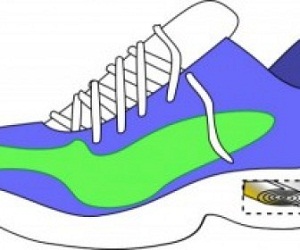Years ago when the first treadmill that could produce electricity from the person using the treadmill. Everybody got excited over the technology. Now something new had top that invention. Since treadmill is too bulky and heavy to carry around, researchers Tom Krupenkin and J. Ashley Taylor has come up with the idea of using shoes to power cellphone, MP3 or laptop.
Their innovation center around the idea called “electrowetting,” in which a drop of an electric conductive liquid positioned on an electrode and bended by the application of electric charge. However, Krupenkin had a different approach the researchers implement the “reverse electrowetting.” In this case, microscopic droplets located between multilayer thin films; as the droplets move — in this case, from the energy of a shoe arrive on the ground — energy created. This energy be capable of harvesting so that the device could be use to power anything.
Their paper, “Reverse electrowetting as a new approach to high-power energy harvesting,” was in print on Aug. 23 in the magazine Nature Communications.
The concept of a captured energy from walking is not new since this idea has begun on the treadmill. Last year, there was a device called the nPower PEG, hidden in the backpack or briefcase that generates emergency power from the movement of the body.
Before the backpack idea, there was also a device that could produce the energy from the movement of a dancer.
 However, earlier systems are not that efficient, it can only produce a few milliwatts of electrical energy. Krupenkin and Taylor believes that their system could create electricity better than the previous attempt to harness electricity from body movement, enough energy to power most lesser devices. To do this, they were thinking of incorporating a USB port in the shoes, allowing any device to be plugged in and get electricity from the energy gathered as the person walks.
However, earlier systems are not that efficient, it can only produce a few milliwatts of electrical energy. Krupenkin and Taylor believes that their system could create electricity better than the previous attempt to harness electricity from body movement, enough energy to power most lesser devices. To do this, they were thinking of incorporating a USB port in the shoes, allowing any device to be plugged in and get electricity from the energy gathered as the person walks.
The device is enough to operate a Wi-Fi hotspot straight from in your shoe. They think that the innovation could help small devices more efficient and survive longer between charges by working as a “middleman” connecting devices and networks.
The two got the idea from soldiers as they need to carry huge power cell so that they could use the communication device in the battle field.
Krupenkin and Taylor have already come up with a name for the company, the InStep NanoPower, LLC, to commercialize the technology.
So far, this is still a concept. They have not started to produced the device.